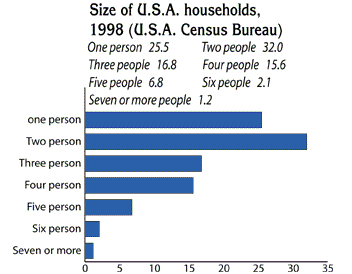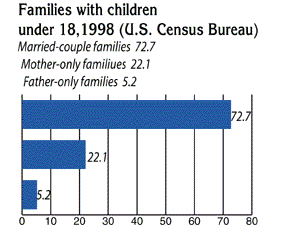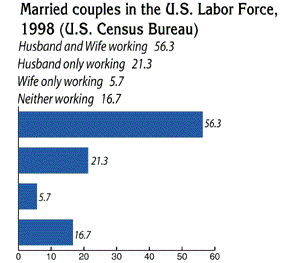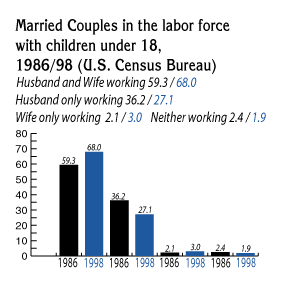|
THE AMERICAN FAMILY, BY THE NUMBERS
The American family has experienced considerable evolution over the past few decades. Statistics bear out the degree of change. Marriage and Family  The average number of persons per U.S. household, among whites and African Americans, has declined over the past three decades from 3.1 in 1970 to 2.6 in 1998 (the latest U.S. Census Bureau figures available). The average number in Hispanic-American households increased from three in 1975 to 3.5 in 1998. Among Asian Americans, the figure has remained steady at 3.2 since 1990 (earlier data are not available). The average number of persons per U.S. household, among whites and African Americans, has declined over the past three decades from 3.1 in 1970 to 2.6 in 1998 (the latest U.S. Census Bureau figures available). The average number in Hispanic-American households increased from three in 1975 to 3.5 in 1998. Among Asian Americans, the figure has remained steady at 3.2 since 1990 (earlier data are not available).
 From 1975 to 1999, according to the Population Reference Bureau, the percentage of adults in the U.S. population who have never been married has increased from 22 to 28 percent. From 1975 to 1999, according to the Population Reference Bureau, the percentage of adults in the U.S. population who have never been married has increased from 22 to 28 percent.
Families, Work and Child Care  In 1998, of married couples in the U.S. labor force, 56.3 percent represented dual-earning couples. In 21.3 percent of the cases, only the husband was working, and in 5.7 percent, only the wife was employed. The remaining percentage represented non-working couples. In 1998, of married couples in the U.S. labor force, 56.3 percent represented dual-earning couples. In 21.3 percent of the cases, only the husband was working, and in 5.7 percent, only the wife was employed. The remaining percentage represented non-working couples.
 The percentage of working mothers with infants has risen dramatically. Of the 3.7 million women in 1998 who had children younger than one year old, 59 percent were working outside the home. The 1996 figure was 31 percent. The percentage of working mothers with infants has risen dramatically. Of the 3.7 million women in 1998 who had children younger than one year old, 59 percent were working outside the home. The 1996 figure was 31 percent.

|





